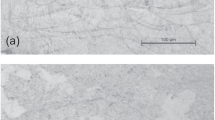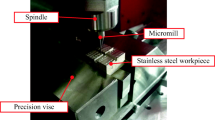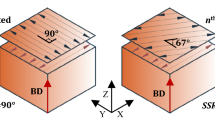Abstract
Additive Manufacturing of metallic parts by powder bed fusion (PBF) has great potential to build complex geometries with innovative materials in a broad field of applications; however, it also presents some limitations as residual stresses, porosities, microcracks, and high roughness that restrict your plateau of productivity. Therefore, an alternative to improve the surface condition of PBF parts is the post-processing as milling. Maraging steel 300 is an important material used in the PBF process, considering its application in different segments, like automotive, tooling, and aerospace. Although there are a few works that investigated the effects of cutting parameters on the surface condition of maraging steel 300 components produced by PBF, this work investigated the effects of different cutting speeds (vc) and feed per tooth (fz) on average roughness Ra and residual stress of maraging 300 specimens. The lowest roughness level of Ra = 0.31 μm was obtained with fz = 0.02 mm/tooth and vc = 250 m/min. Furthermore, the cutting speed had a relevant effect on the compressive behavior of residual stresses. The feed per tooth combined with the cutting speed improved the surface roughness and the compressive residual stress of the specimens, showing the importance of considering both these parameters in the milling process planning of PBF maraging steel parts.














Similar content being viewed by others
References
ASTM International, 52921:2019 - Standard terminology for additive manufacturing - coordinate systems and test (2019) 1–13. https://doi.org/10.1520/F2921
Lou S, Jiang X, Sun W, Zeng W, Pagani L, Scott PJ (2019) Characterisation methods for powder bed fusion processed surface topography. Precis Eng 57:1–15. https://doi.org/10.1016/j.precisioneng.2018.09.007
Kamath C (2016) Data mining and statistical inference in selective laser melting. Int J Adv Manuf Technol 86:1659–1677. https://doi.org/10.1007/s00170-015-8289-2
Becker TH, Dimitrov D (2016) The achievable mechanical properties of SLM produced Maraging Steel 300 components. Rapid Prototyp J 22:487–494. https://doi.org/10.1108/RPJ-08-2014-0096
Jägle EA, Choi PP, Van Humbeeck J, Raabe D (2014) Precipitation and austenite reversion behavior of a maraging steel produced by selective laser melting. J Mater Res 29:2072–2079. https://doi.org/10.1557/jmr.2014.204
Casalino G, Campanelli SL, Contuzzi N, Ludovico AD (2015) Experimental investigation and statistical optimisation of the selective laser melting process of a maraging steel. Opt Laser Technol 65:151–158. https://doi.org/10.1016/j.optlastec.2014.07.021
Fortunato A, Lulaj A, Melkote S, Liverani E, Ascari A, Umbrello D (2018) Milling of maraging steel components produced by selective laser melting. Int J Adv Manuf Technol 94:1895–1902. https://doi.org/10.1007/s00170-017-0922-9
Mutua J, Nakata S, Onda T, Chen ZC (2018) Optimization of selective laser melting parameters and influence of post heat treatment on microstructure and mechanical properties of maraging steel. Mater Des 139:486–497. https://doi.org/10.1016/j.matdes.2017.11.042
Bai Y, Wang D, Yang Y, Wang H (2019) Effect of heat treatment on the microstructure and mechanical properties of maraging steel by selective laser melting. Mater Sci Eng A 760:105–117. https://doi.org/10.1016/j.msea.2019.05.115
Chen Z, Wu X, Tomus D, Davies CHJ (2018) Surface roughness of selective laser melted Ti-6Al-4V alloy components. Addit Manuf 21:91–103. https://doi.org/10.1016/j.addma.2018.02.009
Delfs P, Tows M, Schmid HJ (2016) Optimized build orientation of additive manufactured parts for improved surface quality and build time. Addit Manuf 12:314–320. https://doi.org/10.1016/j.addma.2016.06.003
Promoppatum P, Yao SC (2019) Analytical evaluation of defect generation for selective laser melting of metals. Int J Adv Manuf Technol 103:1185–1198. https://doi.org/10.1007/s00170-019-03500-z
Bai Y, Yang Y, Xiao Z, Wang D (2018) Selective laser melting of maraging steel: mechanical properties development and its application in mold. Rapid Prototyp J 24:623–629. https://doi.org/10.1108/RPJ-05-2017-0104
Mohammadi M, Asgari H (2018) Achieving low surface roughness AlSi10Mg_200C parts using direct metal laser sintering. Addit Manuf 20:23–32. https://doi.org/10.1016/j.addma.2017.12.012
Mercelis P, Kruth JP (2006) Residual stresses in selective laser sintering and selective laser melting. Rapid Prototyp J 12:254–265. https://doi.org/10.1108/13552540610707013
Bhardwaj T, Shukla M (2018) Effect of laser scanning strategies on texture, physical and mechanical properties of laser sintered maraging steel. Mater Sci Eng A 734:102–109. https://doi.org/10.1016/j.msea.2018.07.089
Groover MP (2010) Fundamentals of modern manufacturing - materials, processes, and systems, 4th edn. Wiley, Hoboken
Lu C (2008) Study on prediction of surface quality in machining process. J Mater Process Technol 205:439–450. https://doi.org/10.1016/j.jmatprotec.2007.11.270
Montgomery DC (2008) Design and analysis of experiments, 7th edn. Wiley, Hoboken
Lela B, Bajić D, Jozić S (2009) Regression analysis, support vector machines, and Bayesian neural network approaches to modeling surface roughness in face milling. Int J Adv Manuf Technol 42:1082–1088. https://doi.org/10.1007/s00170-008-1678-z
Tomaz ÍV, Pardal JM, Fonseca MC (2019) Influence of minimum quantity lubrication in the surface quality of milled maraging steel. Int J Adv Manuf Technol 104:4301–4311. https://doi.org/10.1007/s00170-019-04262-4
Lalwani DI, Mehta NK, Jain PK (2008) Experimental investigations of cutting parameters influence on cutting forces and surface roughness in finish hard turning of MDN250 steel. J Mater Process Technol 206:167–179. https://doi.org/10.1016/j.jmatprotec.2007.12.018
Jeelani S, Ramakrishnan K (1985) Surface damage in machining titanium 6Al-2Sn-4Zr-2Mo alloy. J Mater Sci 20:3245–3252. https://doi.org/10.1007/BF00545191
Habiby F, Siddiqui TN, Hussain H, Khan MA, ul Haq A, Khan AQ (1992) Machine-induced phase transformation in a maraging steel. Mater Sci Eng A 159:261–265. https://doi.org/10.1016/0921-5093(92)90297-E
ASM International, ASM Handbook - Heat Treating (1991). https://doi.org/10.1016/S0026-0576(03)90166-8
Tan C, Zhou K, Kuang M, Ma W, Kuang T (2018) Microstructural characterization and properties of selective laser melted maraging steel with different build directions. Sci Technol Adv Mater 19:746–758. https://doi.org/10.1080/14686996.2018.1527645
ASTM International, B962–13 - Standard test methods for density of compacted or sintered powder metallurgy (PM) products using Archimedes’ principle (2013) 1–7. https://doi.org/10.1520/B0962-13.2
Yin S, Chen C, Yan X, Feng X, Jenkins R, O’Reilly P, Liu M, Li H, Lupoi R (2018) The influence of aging temperature and aging time on the mechanical and tribological properties of selective laser melted maraging 18Ni-300 steel. Addit Manuf 22:592–600. https://doi.org/10.1016/j.addma.2018.06.005
Conde FF, Escobar JD, Oliveira JP, Béreš M, Jardini AL, Bose WW, Avila JA (2019) Effect of thermal cycling and aging stages on the microstructure and bending strength of a selective laser melted 300-grade maraging steel. Mater Sci Eng A 758:192–201. https://doi.org/10.1016/j.msea.2019.03.129
ASTM International, E8/E8M Standard test methods for tension testing of metallic materials, Annu. B. ASTM Stand. 4. (2010) 1–27. https://doi.org/10.1520/E0008
ASTM International, E92–16: Standard test methods for Vickers hardness and Knoop hardness of metallic materials, 2016
Morel C, Cioca VV, Lavernhe S, Jardini AL, Conte E (2018) Part surface roughness on laser sintering and milling of maraging steel 300. 14th International Conference on High Speed Manufacturing, San-Sebastian, Spain. hal-01773243
Kempen K, Yasa E, Thijs L, Kruth JP, Van Humbeeck J (2011) Microstructure and mechanical properties of selective laser melted 18Ni-300 steel. Phys Procedia 12:255–263. https://doi.org/10.1016/j.phpro.2011.03.033
Demir AG, Previtali B (2017) Investigation of remelting and preheating in SLM of 18Ni300 maraging steel as corrective and preventive measures for porosity reduction. Int J Adv Manuf Technol 93:2697–2709. https://doi.org/10.1007/s00170-017-0697-z
Hashimura M, Chang YP, Dornfeld D (1999) Analysis of burr formation mechanism in orthogonal cutting. J Manuf Sci Eng Trans ASME 121:1–7. https://doi.org/10.1115/1.2830569
Maconachie T, Leary M, Zhang J, Medvedev A, Sarker A, Ruan D, Lu G, Faruque O, Brandt M (2020) Effect of build orientation on the quasi-static and dynamic response of SLM AlSi10Mg. Mater Sci Eng A 788. https://doi.org/10.1016/j.msea.2020.139445
Chen W (2000) Cutting forces and surface finish when machining medium hardness steel using CBN tools. Int J Mach Tools Manuf 40:455–466. https://doi.org/10.1016/S0890-6955(99)00011-5
Kaynak Y, Tascioglu E (2018) Finish machining-induced surface roughness, microhardness and XRD analysis of selective laser melted Inconel 718 alloy. Procedia CIRP 71:500–504. https://doi.org/10.1016/j.procir.2018.05.013
Du W, Bai Q, Zhang B (2018) Machining characteristics of 18Ni-300 steel in additive/subtractive hybrid manufacturing. Int J Adv Manuf Technol 95:2509–2519. https://doi.org/10.1007/s00170-017-1364-0
Biondani F, Bissacco G, Hansen HN (2020) Surface topography analysis of ball end milled tool steel surfaces. Procedia CIRP. 87:153–158. https://doi.org/10.1016/j.procir.2020.03.002
Navas VG, Gonzalo O, Bengoetxea I (2012) Effect of cutting parameters in the surface residual stresses generated by turning in AISI 4340 steel. Int J Mach Tools Manuf 61:48–57. https://doi.org/10.1016/j.ijmachtools.2012.05.008
Bhardwaj T, Shukla M (2018) Direct metal laser sintering of maraging steel: effect of building orientation on surface roughness and microhardness. Mater Today Proc 5:20485–20491. https://doi.org/10.1016/j.matpr.2018.06.425
Callister WD (2001) Fundamentals of materials science and engineering. Wiley, Hoboken
Acknowledgments
Special thanks are due to Henrique Lopes de Castro, Allison Denis Carros Nizes, Osmando Cardoso, and Julián Arnaldo Ávila Diaz. The authors are grateful to the Multiuser Central Facilities (UFABC) for the experimental support.
Funding
Project grant #2018/11282-0, São Paulo Research Foundation (FAPESP). This study was financed in part by the Coordenação de Aperfeiçoamento de Pessoal de Nível Superior – Brasil (CAPES) – Finance Code 001.
Author information
Authors and Affiliations
Corresponding author
Additional information
Publisher’s note
Springer Nature remains neutral with regard to jurisdictional claims in published maps and institutional affiliations.
Rights and permissions
About this article
Cite this article
Oliveira, A.R., Jardini, A.L. & Del Conte, E.G. Effects of cutting parameters on roughness and residual stress of maraging steel specimens produced by additive manufacturing. Int J Adv Manuf Technol 111, 2449–2459 (2020). https://doi.org/10.1007/s00170-020-06309-3
Received:
Accepted:
Published:
Issue Date:
DOI: https://doi.org/10.1007/s00170-020-06309-3




